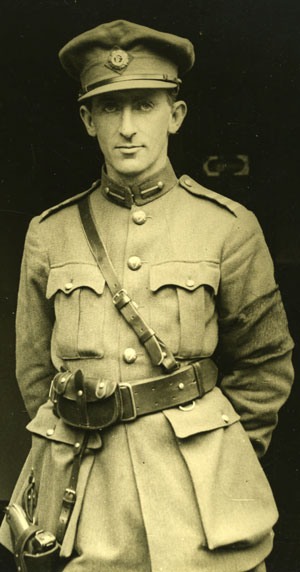FOUR IRA LEADERS EXECUTED IN MOUNTJOY JAIL
Published in Issue 1 (January/February 2023), Volume 31By Joseph E.A. Connell Jr

Above: Richard Mulcahy—appears to have taken the initiative in the cabinet discussion on the executions.
When the Four Courts was captured in June 1922, at the start of the Civil War, 100 IRA prisoners were taken and sent to Mountjoy Jail, among them Rory O’Connor, Liam Mellows, Joe McKelvey and Dick Barrett.
On 7 December 1922, TD Seán Hales was killed outside the Dáil and Leas-Ceann Comhairle Padraic Ó Maille was wounded by the IRA’s Dublin No. 1 Brigade in reprisal for the passage of the Public Safety Bill, the only time when the reprisal orders of Liam Lynch (‘Orders of Frightfulness’—that any TD who voted for the bill was to be killed) were carried out.
Barrett, McKelvey, Mellows and O’Connor were executed in Mountjoy Jail on 8 December 1922 in reprisal for the shooting. This is such an infamous event in the Civil War that there has long been speculation as to who was ‘responsible’. It appears that Richard Mulcahy took the initiative in the cabinet discussion, and that Kevin O’Higgins and Joe McGrath were the last members to give their consent.
The executions took place during the guerrilla phase of the war, a phase that was particularly bitter, and both sides used executions and terror in what developed into a cycle of atrocities. From November 1922 the Provisional Government embarked on a policy of executing IRA prisoners in order to bring the war to an end. Many of those killed had previously been allies, and in some cases close friends during the War of Independence, of those who ordered their deaths in the Civil War. Rory O’Connor was best man at O’Higgins’s wedding in late 1921.
Michael Collins had hoped for a speedy reconciliation of the warring factions, demanding that the IRA must accept the people’s verdict and then could go home without their arms: ‘We want to avoid any possible unnecessary destruction and loss of life. We do not want to mitigate their weakness by resolute action beyond what is required.’
Following the death of Collins on 22 August, however, the Provisional Government, under the leadership of W.T. Cosgrave, Mulcahy and O’Higgins, took the position that the anti-Treaty IRA were conducting an unlawful rebellion against the legitimate Irish government and should be treated as criminals rather than as combatants. O’Higgins in particular voiced the opinion that the use of martial law was the only way to bring the war to an end.
Another factor contributing to the executions policy was the escalating level of violence. In the first two months of the Civil War (July–August 1922) the National Army had successfully taken all the territory held by the IRA and the war seemed all but over. After the anti-Treaty side resorted to guerrilla tactics from late August, National Army casualties mounted and they lost control of some areas of the country.
About the executions Terence de Vere White noted: ‘O’Higgins was appalled, and argued against it in cabinet at great length, only agreeing after Eoin MacNeill, whom he greatly respected, acquiesced. Kevin was the second to last to agree, followed by Joseph McGrath, who was utterly opposed and gave in for the sake of unanimity.’ Yet few in the cabinet shared O’Higgins’s reluctance. Ernest Blythe thought that O’Higgins had been ‘over-sensitive about the executions’.
Besides being members of the IRA Executive, the four represented all of Ireland’s four provinces: O’Connor from Leinster, Barrett from Munster, McKelvey from Ulster and Mellows from Connacht. Their executions were officially expressed ‘as a reprisal for the assassination of Brigadier Seán Hales TD, as a solemn warning to those associated with them who are engaged in the conspiracy of assassination against the representatives of the Irish people’.
In contrast to the 81 official executions by the Irish Free State in the Civil War, the British had executed only 24 IRA Volunteers and the IRA had condemned to death a few dozen enemies during the War of Independence.
Joseph E.A. Connell Jr is the author of The Terror War: the uncomfortable realities of the Irish War of Independence (Eastwood Books).
















